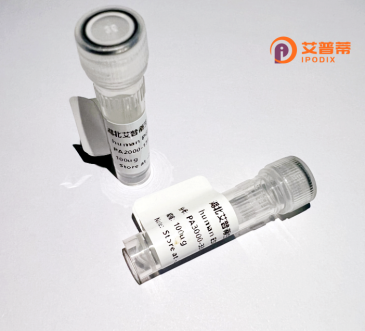
| 纯度 | >90%SDS-PAGE. |
| 种属 | Human |
| 靶点 | TRIM17 |
| Uniprot No | Q9Y577 |
| 内毒素 | < 0.01EU/μg |
| 表达宿主 | E.coli |
| 表达区间 | 1-477 aa |
| 活性数据 | MEAVELARKL QEEATCSICL DYFTDPVMTT CGHNFCRACI QLSWEKARGK KGRRKRKGSF PCPECREMSP QRNLLPNRLL TKVAEMAQQH PGLQKQDLCQ EHHEPLKLFC QKDQSPICVV CRESREHRLH RVLPAEEAVQ GYKLKLEEDM EYLREQITRT GNLQAREEQS LAEWQGKVKE RRERIVLEFE KMNLYLVEEE QRLLQALETE EEETASRLRE SVACLDRQGH SLELLLLQLE ERSTQGPLQM LQDMKEPLSR KNNVSVQCPE VAPPTRPRTV CRVPGQIEVL RGFLEDVVPD ATSAYPYLLL YESRQRRYLG SSPEGSGFCS KDRFVAYPCA VGQTAFSSGR HYWEVGMNIT GDALWALGVC RDNVSRKDRV PKCPENGFWV VQLSKGTKYL STFSALTPVM LMEPPSHMGI FLDFEAGEVS FYSVSDGSHL HTYSQATFPG PLQPFFCLGA PKSGQMVIST VTMWVKG |
| 分子量 | 54.4 kDa |
| 蛋白标签 | His tag N-Terminus |
| 缓冲液 | PBS, pH7.4, containing 0.01% SKL, 1mM DTT, 5% Trehalose and Proclin300. |
| 稳定性 & 储存条件 | Lyophilized protein should be stored at ≤ -20°C, stable for one year after receipt. Reconstituted protein solution can be stored at 2-8°C for 2-7 days. Aliquots of reconstituted samples are stable at ≤ -20°C for 3 months. |
| 复溶 | Always centrifuge tubes before opening.Do not mix by vortex or pipetting. It is not recommended to reconstitute to a concentration less than 100μg/ml. Dissolve the lyophilized protein in distilled water. Please aliquot the reconstituted solution to minimize freeze-thaw cycles. |
1. **"TRIM17 contributes to the regulation of apoptosis through ubiquitination of BAX"** - L. Li et al. (2020)
摘要:该研究揭示了TRIM17作为E3泛素连接酶,通过直接泛素化促凋亡蛋白BAX调控线粒体途径的细胞凋亡,影响癌症细胞的化疗敏感性。
2. **"TRIM17 inhibits autophagy by targeting ULK1 ubiquitination in Parkinson's disease models"** - M. Rossi et al. (2019)
摘要:研究表明,TRIM17通过泛素化修饰自噬关键激酶ULK1.抑制神经元自噬活性,导致α-突触核蛋白异常聚集,与帕金森病进展相关。
3. **"TRIM17-driven degradation of MCL1 sensitizes glioblastoma cells to temozolomide"** - C. Huang & J. Wei (2021)
摘要:发现TRIM17在胶质母细胞瘤中通过促进抗凋亡蛋白MCL1的泛素化降解,增强替莫唑胺诱导的细胞死亡,提示其作为治疗增敏靶点的潜力。
4. **"Non-canonical ubiquitination by TRIM17 promotes proteasomal degradation of substrates"** - K. Tanaka et al. (2018)
摘要:揭示了TRIM17独立于E1/E2酶的非常规泛素化机制,通过直接与蛋白酶体结合加速底物降解,拓展了对TRIM家族蛋白功能多样性的理解。
TRIM17. a member of the tripartite motif (TRIM) protein family, is characterized by its conserved N-terminal RING domain, B-box motifs, and coiled-coil regions, which are hallmarks of this ubiquitin E3 ligase family. Primarily expressed in the brain, testes, and immune cells, TRIM17 plays multifaceted roles in cellular processes, including apoptosis, autophagy, and innate immune responses. It regulates protein degradation by promoting ubiquitination of specific substrates, though its targets and mechanisms remain less characterized compared to other TRIM proteins.
Notably, TRIM17 exhibits context-dependent functions. In neuronal cells, it modulates neurodegeneration pathways, potentially linking it to disorders like Parkinson’s and Alzheimer’s diseases. Studies suggest it interacts with autophagy-related proteins (e.g., SQSTM1/p62) and influences mitochondrial integrity, impacting cell survival under stress. Paradoxically, TRIM17 can act as both a tumor suppressor and promoter in cancers, either by inducing apoptosis or enhancing metastasis through pathways like EMT (epithelial-mesenchymal transition).
Emerging research highlights its role in regulating inflammation and viral defense, possibly by antagonizing antiviral TRIM proteins. Despite progress, TRIM17’s exact molecular networks and therapeutic potential require further exploration. Its dualistic behavior across tissues underscores the importance of cell-specific microenvironments in determining its functional outcomes, making it a compelling target for disease mechanism studies and drug development.
×